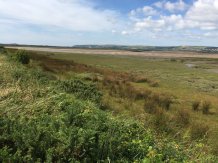
Credit Dr Katrina Davis
New study demonstrates benefits of undervalued saltmarsh
A new tool which helps land managers assess the costs and benefits of re-introducing valuable saltmarsh, has been developed by economists and environmental scientists from the South West Partnership for Environmental and Economic Prosperity (SWEEP) at the University of Exeter.
Saltmarshes can be found in sheltered coastal areas and are expanses of salt water tolerant grassland, exposed at low tide. The study shows that saltmarsh has a positive effect on the local and wider environment by providing an important habitat for wading birds, nursery grounds for fish, and natural flood defences.
Yet the habitat is in decline with around half being lost around the world because of sea level rise, changes to water nutrient levels from agricultural run-off, and land development – saltmarsh competes with the high-value of coastal land for grazing or property development.
The SWEEP study, which was produced alongside partners from the North Devon Biosphere, promotes a new way for land managers and planners to appraise coastal land to fully capture the benefits saltmarsh brings to the environment and local economy.
The research team collaborated with the North Devon Biosphere Reserve on the study because it is an area that has seen significant decline in saltmarsh (the data reveals an overall decline of 23.7%) but also, through the North Devon Landscape Pioneer Project it is the ideal test bed for managing the reintroduction of these unique habitats.
“Globally, it’s estimated we’ve lost about 50% of our saltmarsh, and in the UK it’s declining by around 100 hectares each year,” said lead author and SWEEP Impact Fellow, Dr Katrina Davis.
“These patches of coastline are squeezed by rising sea levels on one side, and repurposed into farm or development land on the other. Land used for farming or development has the perception of being ‘higher value’, but by looking at the whole picture – the knock-on effects to fish stocks, the cost of man-made flood defences, the benefits to health and wellbeing - you are able to appreciate the full value of saltmarsh.”
The article advocates using an economics-based ‘Natural Capital’ approach to identify sites where restoring or creating saltmarsh will reap the most benefits. Natural capital approaches are being increasingly adopted by governments and land managers, and are a more inclusive way of bringing the natural environment into decision-making.
Andy Bell, UNESCO World Biosphere Reserve Co-ordinator, contributed to the article.
“It has been a really worthwhile investigation to look at how Natural Capital economics can bring a different slant to the value of nature and indeed where we can best restore natural sites for the benefit of all. We welcome continuing to work with SWEEP to identify the best sites for habitat creation that are technically feasible, using the hydrology of the estuary as the driving factor with the Defra Natural Flood Management programme.”
It is hoped that the framework developed in this study will be adopted by land managers around the country to help them prioritise sites, and manage or reinstate saltmarsh in their own area.
The study is published in the Journal of Environmental Economics and Policy and is available from https://www.tandfonline.com/doi/full/10.1080/21606544.2018.1537197
Date: 23 January 2019
